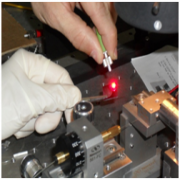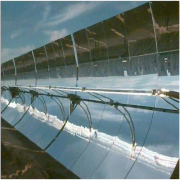High-voltage photovoltaic cells
PV cells can achieve higher efficiencies under concentrated sunlight with vertical multi-junction structure, producing high voltage and low current.
PV cells can achieve higher efficiencies under concentrated sunlight with vertical multi-junction structure, producing high voltage and low current.
The common structure of PV cells produces low voltage and high current. This leads to high losses due both to current mismatch when cells are connected together in panels, and to electrical resistance, especially in concentrator systems where currents are high. The Vertical Multi-Junction (VMJ) approach on the other hand produces cells with high voltage and low current, thereby reducing electrical resistance losses (which depend on the current), and enabling a different configuration for connecting the cells (parallel instead of series) that minimises mismatch effects. We have shown that a VMJ cell in silicon can achieve significantly higher efficiencies than those previously demonstrated (close to 30%, compared to around 20% in previous work). The essential difference lies in the design of the basic unit in the cell, the single junction, which needs to be much narrower than in previous designs in order to achieve optimal conversion efficiency. The optimised VMJ cells also operate efficiently at much higher concentrations than conventional cells made from the same material, for example at more than 1000 suns for silicon cells, while the performance of conventional silicon cells degrades at concentrations exceeding about 300. We are currently investigating different cell structure options, together with corresponding methods of cell manufacture, to find designs that would be both inexpensive and practical.
Collaboration: R Sarfaty (OBC)
Support: Israel Ministry of National Infrastructure







